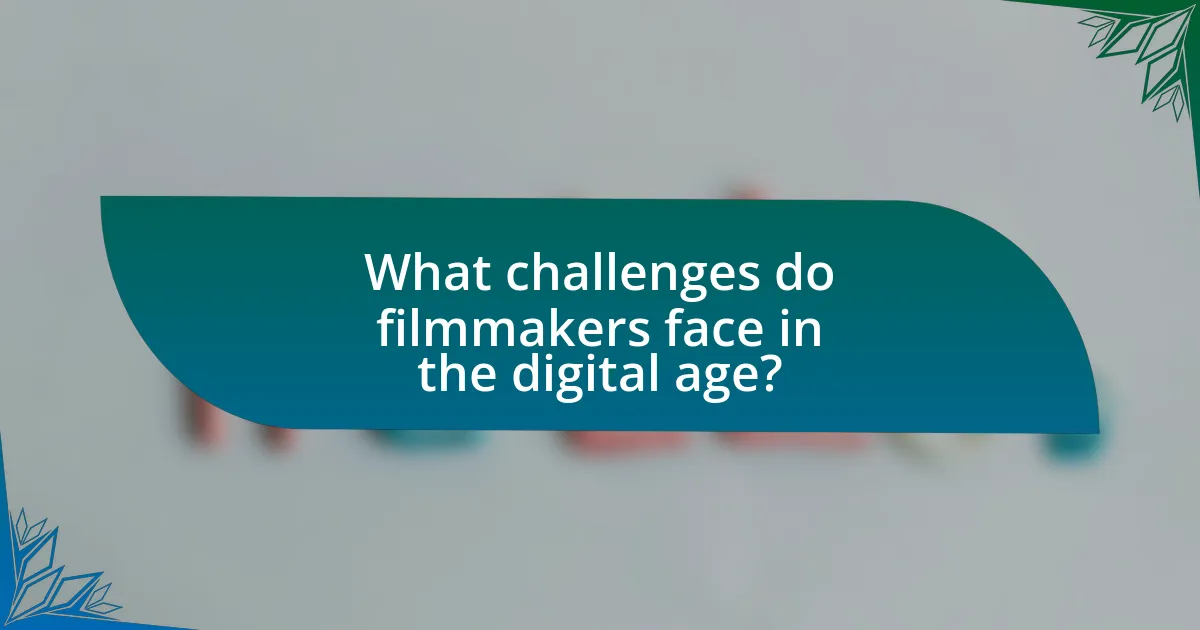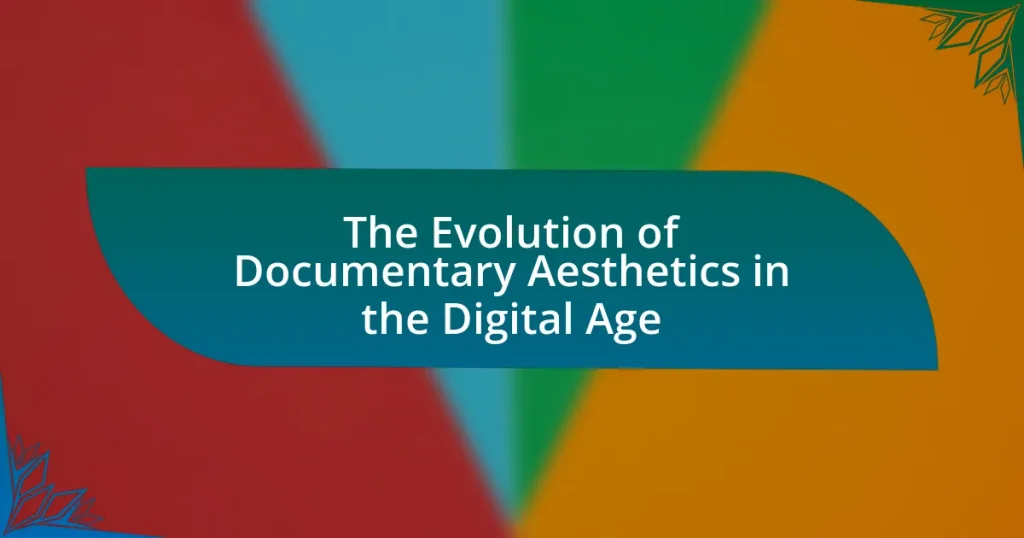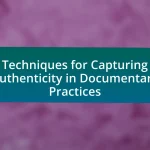The article examines the evolution of documentary aesthetics in the digital age, highlighting how advancements in technology have transformed storytelling methods. Key topics include the impact of high-definition video, digital editing software, and streaming platforms on documentary production and distribution. The discussion also covers emerging narrative techniques, the role of aesthetics in audience engagement and perception of truth, and the ethical considerations filmmakers face in this evolving landscape. Additionally, it addresses the challenges of budget constraints and the importance of representation and bias in digital documentaries.

What is the Evolution of Documentary Aesthetics in the Digital Age?
The evolution of documentary aesthetics in the digital age is characterized by the integration of new technologies, which has transformed traditional storytelling methods. Digital tools such as high-definition cameras, editing software, and online distribution platforms have enabled filmmakers to create more visually dynamic and accessible content. For instance, the rise of social media has facilitated the emergence of short-form documentaries, allowing for immediate audience engagement and feedback. Additionally, the use of interactive elements and virtual reality has expanded the boundaries of documentary storytelling, providing immersive experiences that were previously unattainable. This shift reflects a broader trend towards democratization in filmmaking, where diverse voices can share their narratives without the constraints of traditional media gatekeepers.
How has technology influenced documentary aesthetics?
Technology has significantly influenced documentary aesthetics by enabling new forms of storytelling and visual representation. The advent of digital cameras and editing software has allowed filmmakers to capture high-quality footage more easily and affordably, resulting in a broader range of visual styles and techniques. For instance, the use of drones has introduced aerial perspectives that were previously difficult to achieve, enhancing the narrative depth and visual appeal of documentaries. Additionally, advancements in streaming platforms have shifted the way documentaries are distributed and consumed, allowing for more experimental formats and interactive elements, which engage audiences in novel ways. These technological innovations have transformed traditional documentary practices, making them more accessible and diverse in aesthetic expression.
What are the key technological advancements impacting documentaries?
Key technological advancements impacting documentaries include high-definition video, digital editing software, and streaming platforms. High-definition video allows for clearer and more immersive storytelling, enhancing viewer engagement. Digital editing software, such as Adobe Premiere Pro and Final Cut Pro, enables filmmakers to manipulate footage with precision, facilitating creative expression and efficiency in production. Streaming platforms like Netflix and Amazon Prime Video have transformed distribution, providing wider access to audiences and allowing for diverse documentary content to reach global viewers. These advancements collectively enhance the quality, accessibility, and reach of documentary filmmaking.
How do these advancements change the way stories are told?
Advancements in technology, such as digital filmmaking, virtual reality, and interactive media, significantly change the way stories are told by enhancing viewer engagement and expanding narrative possibilities. Digital filmmaking allows for higher quality visuals and sound, making stories more immersive and accessible. Virtual reality creates an interactive experience where viewers can explore narratives from multiple perspectives, fostering a deeper emotional connection. Interactive media, including web documentaries and transmedia storytelling, enables audiences to participate in the narrative, influencing the direction of the story. These advancements have transformed traditional storytelling methods, allowing for more dynamic and participatory experiences that reflect contemporary audience expectations and technological capabilities.
Why is understanding documentary aesthetics important?
Understanding documentary aesthetics is important because it shapes how audiences perceive and interpret the content presented in documentaries. The visual and auditory elements, such as framing, lighting, sound design, and editing, influence emotional engagement and the overall narrative. For instance, a study by Bill Nichols in “Introduction to Documentary” highlights that aesthetic choices can manipulate viewer responses, guiding them toward specific interpretations of reality. This understanding allows filmmakers to effectively communicate their messages and engage viewers on a deeper level, ultimately enhancing the impact of the documentary.
What role do aesthetics play in audience engagement?
Aesthetics play a crucial role in audience engagement by influencing emotional responses and perceptions of content. Engaging visuals, sound design, and overall presentation can captivate viewers, making them more likely to connect with the narrative. Research indicates that aesthetically pleasing content can enhance viewer retention and satisfaction, as seen in studies where high-quality visuals led to increased audience interest and emotional involvement. For instance, a study published in the Journal of Visual Communication in Medicine found that well-designed visual elements significantly improved audience engagement and information retention.
How do aesthetics affect the perception of truth in documentaries?
Aesthetics significantly influence the perception of truth in documentaries by shaping viewers’ emotional responses and engagement with the content. The visual style, including cinematography, editing, and sound design, can enhance or obscure the authenticity of the narrative presented. For instance, a study by Bill Nichols in “Introduction to Documentary” highlights that stylistic choices can create a sense of realism or artifice, impacting how audiences interpret the credibility of the information. When documentaries employ polished visuals and dramatic music, they may evoke a heightened emotional response, which can lead viewers to perceive the content as more truthful, even if it is selectively edited or dramatized. Conversely, a raw and unfiltered aesthetic may foster a sense of authenticity, encouraging viewers to trust the documentary’s portrayal of reality. Thus, the interplay between aesthetics and perceived truth is crucial in shaping audience interpretations of documentary narratives.

What are the key trends in documentary aesthetics today?
Key trends in documentary aesthetics today include the use of immersive storytelling techniques, the integration of interactive elements, and a focus on authenticity through raw, unfiltered visuals. Immersive storytelling, often enhanced by virtual reality and augmented reality, allows viewers to engage with narratives in a more participatory manner. Interactive elements, such as audience-driven content choices, are increasingly utilized to create a personalized viewing experience. Additionally, the emphasis on authenticity is reflected in the preference for handheld camera work and natural lighting, which convey a sense of immediacy and realism. These trends are supported by the rise of digital platforms that prioritize viewer engagement and the democratization of content creation, allowing diverse voices to shape documentary aesthetics.
How has the rise of digital platforms changed documentary styles?
The rise of digital platforms has significantly transformed documentary styles by enabling greater accessibility and interactivity. Digital platforms allow filmmakers to reach wider audiences without traditional distribution barriers, leading to diverse storytelling techniques that incorporate user-generated content and real-time engagement. For instance, platforms like YouTube and Vimeo have popularized short-form documentaries and series that cater to online viewing habits, emphasizing concise narratives and visual appeal. Additionally, the integration of social media has encouraged documentaries to adopt participatory styles, inviting audience interaction and feedback, which can shape the narrative. This shift is evidenced by the success of interactive documentaries, such as “Bear 71,” which utilizes web-based formats to create immersive experiences, demonstrating how digital platforms have redefined the boundaries of documentary filmmaking.
What are the most popular formats for digital documentaries?
The most popular formats for digital documentaries include web series, interactive documentaries, and short films. Web series allow for episodic storytelling, engaging audiences over multiple installments, while interactive documentaries enable viewer participation and exploration of content, enhancing engagement. Short films, often under 30 minutes, cater to the growing demand for concise storytelling in the digital landscape. According to a report by the International Documentary Association, the rise of streaming platforms has significantly influenced these formats, with web series and interactive content gaining traction due to their accessibility and appeal to younger audiences.
How do streaming services influence documentary production?
Streaming services significantly influence documentary production by providing new funding models and broader distribution channels. These platforms, such as Netflix and Amazon Prime, have increased demand for diverse documentary content, leading to higher budgets and more creative freedom for filmmakers. For instance, Netflix invested over $250 million in documentary films in 2020 alone, allowing creators to explore innovative storytelling techniques and reach global audiences. This shift has resulted in a surge of high-quality documentaries that cater to niche interests, reflecting the evolving tastes of viewers in the digital age.
What new narrative techniques are emerging in digital documentaries?
New narrative techniques emerging in digital documentaries include interactive storytelling, immersive experiences through virtual reality, and nonlinear narratives. Interactive storytelling allows viewers to engage with the content actively, making choices that affect the narrative outcome, as seen in projects like “Bear 71.” Immersive experiences utilize virtual reality to place viewers within the documentary environment, enhancing emotional engagement, exemplified by “The Hangman at Home.” Nonlinear narratives break traditional storytelling structures, allowing for a more fragmented and multifaceted exploration of themes, as demonstrated in “The Act of Killing.” These techniques reflect the evolving landscape of documentary aesthetics in the digital age, driven by advancements in technology and changing audience expectations.
How do interactive elements enhance storytelling?
Interactive elements enhance storytelling by actively engaging the audience, allowing them to influence the narrative and experience the story in a personalized manner. This engagement fosters a deeper emotional connection, as users can make choices that affect the outcome, thereby increasing investment in the narrative. Research indicates that interactive storytelling can lead to higher retention rates and satisfaction levels among audiences, as evidenced by studies showing that participants in interactive narratives report greater enjoyment and involvement compared to traditional storytelling formats.
What is the impact of user-generated content on documentary aesthetics?
User-generated content significantly impacts documentary aesthetics by introducing diverse perspectives and informal styles that challenge traditional filmmaking norms. This content often features raw, unedited footage that enhances authenticity, allowing viewers to connect more personally with the subject matter. For instance, documentaries like “The Act of Killing” incorporate user-generated elements to present complex narratives, demonstrating how grassroots contributions can reshape storytelling techniques. Additionally, the rise of platforms like YouTube has democratized documentary production, enabling a broader range of voices and visual styles, which further enriches the aesthetic landscape of the genre.

What challenges do filmmakers face in the digital age?
Filmmakers face several challenges in the digital age, including oversaturation of content, rapid technological changes, and evolving audience expectations. The oversaturation of content results from the low barrier to entry for digital filmmaking, leading to an overwhelming amount of material that makes it difficult for individual projects to stand out. Rapid technological changes require filmmakers to continuously adapt to new tools and platforms, which can be resource-intensive and may necessitate ongoing training. Additionally, evolving audience expectations, driven by the accessibility of high-quality content, push filmmakers to innovate and maintain high production values, often increasing pressure on budgets and timelines. These challenges highlight the complexities filmmakers must navigate to succeed in a competitive digital landscape.
How do budget constraints affect documentary production?
Budget constraints significantly limit the resources available for documentary production, impacting aspects such as crew size, equipment quality, and post-production capabilities. Limited budgets often force filmmakers to prioritize essential elements, leading to compromises in production value and potentially affecting the storytelling quality. For instance, a study by the International Documentary Association found that 70% of independent documentaries operate on budgets under $250,000, which restricts access to high-quality cameras and professional editing software. Consequently, filmmakers may rely on lower-cost alternatives, which can influence the overall aesthetic and narrative depth of the documentary.
What are the implications of low-budget filmmaking on aesthetics?
Low-budget filmmaking significantly impacts aesthetics by prioritizing resourcefulness over traditional production values. This constraint often leads filmmakers to adopt innovative techniques, such as handheld camera work, natural lighting, and minimalistic set designs, which can create a raw and authentic visual style. For instance, films like “The Blair Witch Project” and “Paranormal Activity” utilized low budgets to enhance their aesthetic appeal through a documentary-like realism, engaging audiences by making them feel part of the narrative. Additionally, the rise of digital technology has democratized filmmaking, allowing creators to produce high-quality visuals without substantial financial backing, further influencing the aesthetic landscape of contemporary cinema.
How can filmmakers overcome financial limitations?
Filmmakers can overcome financial limitations by utilizing crowdfunding platforms, which allow them to raise funds directly from potential audiences. For instance, successful campaigns on platforms like Kickstarter and Indiegogo have enabled filmmakers to secure budgets that would otherwise be unattainable through traditional financing methods. In 2020, over $1 billion was raised through crowdfunding for creative projects, demonstrating its effectiveness as a viable funding source. Additionally, filmmakers can leverage digital technology to reduce production costs, such as using affordable cameras and editing software, which have become increasingly accessible. This shift has allowed independent filmmakers to produce high-quality content without the need for large budgets, as evidenced by the rise of low-budget films that achieve critical and commercial success.
What ethical considerations arise in digital documentary filmmaking?
Ethical considerations in digital documentary filmmaking include issues of consent, representation, and the potential for exploitation. Filmmakers must obtain informed consent from subjects, ensuring that individuals understand how their stories will be portrayed and the implications of their participation. Additionally, accurate representation is crucial; filmmakers have a responsibility to depict subjects authentically and avoid perpetuating stereotypes or biases. Exploitation can occur when filmmakers prioritize sensationalism over the well-being of their subjects, particularly in vulnerable communities. These ethical challenges are underscored by the rise of digital platforms, which can amplify both the reach and impact of documentaries, necessitating a heightened awareness of ethical standards in the filmmaking process.
How does the digital landscape affect representation and bias?
The digital landscape significantly affects representation and bias by amplifying diverse voices while also perpetuating existing stereotypes. Online platforms enable marginalized groups to share their narratives, leading to a broader spectrum of representation in media. However, algorithms that prioritize certain content can reinforce biases, as seen in studies showing that social media algorithms often favor sensational or polarizing content, which can skew public perception and reinforce stereotypes. For instance, research by the Pew Research Center indicates that algorithm-driven content can lead to echo chambers, where users are exposed primarily to viewpoints that align with their own, further entrenching biases. Thus, while the digital landscape offers opportunities for enhanced representation, it simultaneously poses risks of bias reinforcement through algorithmic curation.
What responsibilities do filmmakers have towards their subjects?
Filmmakers have a responsibility to portray their subjects with accuracy, respect, and ethical consideration. This includes obtaining informed consent, ensuring that subjects understand how their stories will be represented, and being transparent about the filmmaking process. Ethical guidelines, such as those outlined by the International Documentary Association, emphasize the importance of honesty and integrity in representation, which helps to prevent exploitation and misrepresentation of individuals and communities. Furthermore, filmmakers should strive to provide context and avoid sensationalism, thereby fostering a more nuanced understanding of the subjects’ experiences.
What best practices can filmmakers adopt in the digital age?
Filmmakers can adopt several best practices in the digital age, including leveraging digital distribution platforms, utilizing social media for audience engagement, and embracing new technologies for production and post-production. Digital distribution platforms like Netflix and Amazon Prime allow filmmakers to reach global audiences without traditional gatekeepers, enhancing visibility and accessibility. Social media channels such as Instagram and TikTok enable filmmakers to build communities and engage directly with viewers, fostering a loyal fan base. Additionally, advancements in technology, such as high-quality digital cameras and editing software, empower filmmakers to produce professional-grade content at lower costs, democratizing the filmmaking process. These practices are supported by industry trends indicating a significant shift towards digital consumption, with over 80% of viewers preferring streaming services for content access.
How can filmmakers effectively utilize social media for promotion?
Filmmakers can effectively utilize social media for promotion by creating engaging content that resonates with their target audience. This includes sharing behind-the-scenes footage, trailers, and interactive posts that encourage audience participation. According to a 2021 survey by the Pew Research Center, 69% of adults in the U.S. use social media, making it a vital platform for reaching potential viewers. Additionally, filmmakers can leverage targeted advertising on platforms like Facebook and Instagram to reach specific demographics, enhancing their promotional efforts. Engaging with followers through comments and live Q&A sessions can also foster a community around the film, increasing visibility and interest.
What strategies can enhance audience engagement with documentaries?
To enhance audience engagement with documentaries, filmmakers can utilize interactive elements, social media integration, and targeted storytelling. Interactive elements, such as choose-your-own-adventure formats or augmented reality features, allow viewers to immerse themselves in the narrative, increasing emotional investment. Social media integration fosters community discussions and sharing, which can amplify reach and viewer connection. Targeted storytelling, which focuses on relatable themes and personal narratives, resonates more deeply with audiences, as evidenced by the success of documentaries like “13th,” which sparked widespread conversation about racial inequality. These strategies collectively create a more engaging viewing experience, encouraging audiences to connect with the content on multiple levels.


